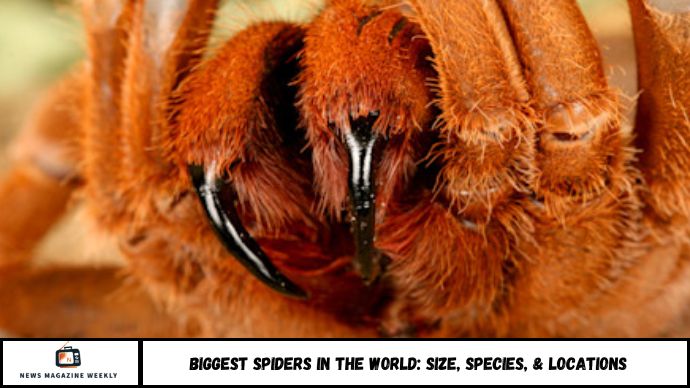Spiders are often misunderstood, but some species captivate scientists and enthusiasts with their sheer size. In this guide, we introduce the biggest spiders in the world, explore how large they truly get, and reveal where these enormous arachnids live. From South America’s rainforests to deserts in Australia, these giant spiders are more fascinating than fearsome.
For years, scientists believed they had discovered the largest spider to ever walk the Earth. The fossil, found in Argentina, was named Megarachne a name that conjured images of a monster straight out of a sci-fi thriller. With legs stretching nearly 20 inches and a body longer than most people’s forearms, it seemed like something out of nightmares.
But the truth was stranger than fiction. By the early 2000s, further research revealed that Megarachne wasn’t a spider at all, but a species of prehistoric sea scorpion. Disappointing for arachnid enthusiasts? Maybe. Yet, that doesn’t mean the modern world is free of giants.
In fact, some living spider species today are enormous—larger than dinner plates, heavier than small pets, and just as terrifying to stumble upon in the wild. In this article, we’ll explore the biggest spiders alive today, how big they really get, and where you can find these massive arachnids in the real world.
Why Are Some Spiders So Big?
Did you know that some spiders grow to the size of a dinner plate? While most spider species are tiny and harmless, a few have evolved to become massive predators within their ecosystems.
These spiders aren’t just big for show — their size offers hunting advantages, allows them to consume larger prey, and helps them survive in dense, biodiverse regions. But before you panic, know this: even the largest spiders rarely pose a threat to humans.
In this article, we’ll explore:
- The top 5 biggest spider species on Earth
- Their size, behaviors, and habitats
- Where to see them (safely)
- Fascinating facts and science behind their size
Top 5 Biggest Spiders in the World
1. Goliath Birdeater (Theraphosa blondi)
- Leg span: Up to 12 inches (30 cm)
- Weight: Up to 6 ounces (170 grams)
- Location: Northern South America (Brazil, Venezuela, Guyana)
- Fun fact: Despite its name, it rarely eats birds—though it’s capable of doing so. It primarily hunts insects, rodents, frogs, and even snakes.
Why it’s impressive: This is the heaviest spider in the world and holds the record for largest by mass.
2. Giant Huntsman Spider (Heteropoda maxima)
- Leg span: Up to 12 inches (30 cm)
- Weight: Lighter than the Goliath but longer in leg length
- Location: Laos (cave systems)
- Fun fact: Known for its incredible speed and crab-like sideways movement.
Notable trait: Holds the record for the largest leg span of any spider.
3. Brazilian Salmon Pink Birdeater (Lasiodora parahybana)
- Leg span: Up to 10 inches (25 cm)
- Location: Brazil’s Atlantic forest
- Color: Reddish-pink leg hairs give it a striking appearance
- Fun fact: It’s popular in the exotic pet trade and can live up to 15 years.
Behavior: Despite its intimidating size, it’s usually docile when handled carefully.
4. Hercules Baboon Spider (Hysterocrates hercules)
- Leg span: Up to 8 inches (20 cm)
- Location: Nigeria (rare sightings)
- Fun fact: It’s one of the most elusive species — known from only one preserved specimen discovered over 100 years ago.
Status: Considered potentially extinct or extremely rare in the wild.
5. Colombian Giant Redleg (Megaphobema robustum)
- Leg span: Around 7–8 inches (18–20 cm)
- Location: Colombia and Brazil (rainforests)
- Appearance: Thick red legs and a robust body
- Fun fact: Uses its spiny rear legs defensively to kick at predators.
Behavior: Shy and non-aggressive; prefers to flee than fight.
What Makes These Spiders Grow So Large?
The largest spiders often live in humid, warm environments with abundant food sources and fewer natural predators. Their size allows them to:
- Hunt bigger prey
- Store more nutrients
- Intimidate predators
- Thrive in ecologically rich ecosystems like tropical rainforests or deep caves
Additionally, terrestrial tarantulas benefit from having strong legs and heavy bodies since they don’t rely on webs to hunt — they actively ambush prey.
Where to See These Giant Spiders Safely
If you’re interested in spotting (or photographing) these massive arachnids, here’s where you can safely find them:
- Rainforests in Brazil or Guyana – for Goliath Birdeaters and Salmon Pinks
- Cave tours in Laos – to (possibly) glimpse a Giant Huntsman
- Nature reserves in Colombia – to observe the Colombian Giant Redleg
- Zoos or arachnid exhibits – many keepers house large tarantulas for education
- Reputable exotic pet expos – some of these spiders are kept by hobbyists under legal permits
FAQs
1. Are the largest spiders venomous?
Yes, but their venom is generally not dangerous to humans — it’s designed to subdue prey like insects or small rodents.
2. Can giant spiders kill people?
No known species of spider, including the largest ones, has venom potent enough to kill a healthy adult human.
3. Do big spiders build large webs?
Most giant spiders, especially tarantulas, are ground-dwellers that don’t use webs for hunting.
4. Why are spiders in tropical areas bigger?
Warm climates, abundant prey, and fewer environmental constraints support larger body sizes.
5. How long do large spiders live?
Some female tarantulas can live 15 to 25 years in captivity, and around 10 years in the wild.
6. Are these spiders endangered?
Some, like the Hercules Baboon Spider, are possibly extinct or at least extremely rare due to habitat loss and lack of sightings.
Conclusion
The world’s biggest spiders may look terrifying, but they’re truly marvels of evolution. From their adaptive hunting methods to their massive physical forms, these arachnids are an essential part of their ecosystems.
If you ever come across one — whether in the wild or at a zoo — appreciate the creature from a respectful distance. These giants remind us that nature often defies our expectations and that beauty can be found even in the most misunderstood corners of the animal kingdom.

